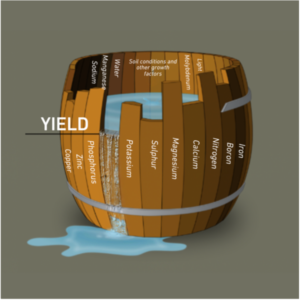Historically, the precision ag industry has not done a great job articulating the value of site-specific soil testing. The utility of the process has never been well defined. Grid sampling, most commonly done in 2.5 acre grids, was introduced in the mid 1990s. This was before the advent of yield monitors and with the goal of raising overall fertility to a static level to achieve optimum, more consistent results based on what is known about the correlation between nutrient concentration and yield. While the practice was deemed good (increasing granularity of assessment of nutrient/pH values), the promise of evening out soil sample concentrations was never achieved. This was due to a large portion of fertilizer applications utilizing a field level average yield goal and not machine captured yield data to spatially assess what grain was harvested and ultimately nutrient removal. Upon resample, soil test results were inconsistent and yield improvement was hard to document, leading many growers to question the effort and cost or even abandon the practice entirely. We regularly hear from our prospective customers:
“I’ve never seen the value in soil sampling. I used to do it, but haven’t recently.”

“There is no relationship between soil test values and yield”.
While both statements are valid given their experiences, what are we actually trying to accomplish with soil testing? By definition, soil testing provides an estimation of the soil chemical concentration (plant required nutrients and pH) as well as its physical properties (organic matter and cation exchange capacity). Shouldn’t that be enough information to use in making fertility and seed placement decisions? It’s good, but we believe growers can do better.
What is missing in that assessment is nutrient availability. Soil temperature, soil moisture/rainfall, landscape position and other factors all have profound effects on nutrient utilization and uptake. Given a uniform concentration of nutrients in the soil, a plant will respond differently depending on where it stands in the landscape, ultimately depending on soil moisture content. This relationship of soil moisture to nutrient availability needs to be a driving factor in the placement of soil sample collection points in areas where differences in soil moisture will exist (landscape position, differences in organic matter and cation exchange capacity) with reference to spatial yield data variability.
While some nutrients like nitrate and sulfate move to the root by mass flow of soil water, many of our soil immobile nutrients like phosphorus (P) and potassium (K) move by diffusion. During the growing season, the mechanism of diffusion, or movement of high concentration to low concentration, is created by plant uptake (creating a zone of lower concentration). This is also dependent on soil moisture content. Lower soil moisture percentages hinder the movement of P and K, thus reducing the availability during periods where the soil cannot supply these nutrients in enough quantities to fulfill plant requirements. Looking across a soybean field, think about dry conditions from past seasons and you’ll see that K deficiency most consistently shows up on higher ground first.
A prescribed rate of nutrients takes into account the soil sample, but also includes a critical level or a soil test level where additional nutrient applications will not improve yield (Liebig’s Law of the Minimum, Figure 1). While most prescriptions use a static critical level across a field or even a state, Advanced Agrilytics’ methodology takes into account soil test concentrations and also includes a spatial critical level. This incorporates factors that influence soil water holding capacity (OM and CEC) as well as landscape position (elevation, slope, and soil wetness index). Advanced Agrilytics’ processes require OM and CEC in the results of every soil test for this very reason – to understand the soil moisture dynamics of every acre. Organic matter and CEC taken together with elevation provide improved guidance of not only what the nutrient concentration of a soil is, but also how to prolong nutrient availability as soils become dry during later vegetative and reproductive crop stages.

Soil test OM also provides guidance for nitrogen applications. Mineralization of N from the soil organic fraction is important and can supply as much as 150 lbs. N or as little as 30 lbs. N during the growing season in the same field. Spatially understanding N mineralization aids in deriving a VRN prescription that not only provides yield improvement this season, but also creates stability in yield (wet or dry season) year after year. This is because the prescription addresses the factors that influence N availability (saturated soils that will lose N due to denitrification and/or leaching and soils that have less OM, are higher in elevation (less moisture for mineralization) and will supply less N for the growing crop.

In summary, soil sampling can be a critical piece to establish a baseline from with to measure performance and optimize the return on investment for your fertilizer and seeding decisions. Evaluate your current program today. Is it satisfying the objectives you have on your farm this year and in years to come? Reach out to a Precision Agronomist today to begin unlocking the potential of every acre.